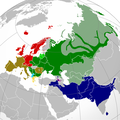Papeles:Indo-European branches map.png

Kadakkel daytoy a panagipadas: 599 × 600 dagiti piksel. Sabali kadagiti resolusion: 240 × 240 dagiti piksel | 479 × 480 dagiti piksel | 767 × 768 dagiti piksel | 1,023 × 1,024 dagiti piksel | 2,045 × 2,048 dagiti piksel | 2,934 × 2,938 dagiti piksel.
Kasisigud a papeles (2,934 × 2,938 dagiti piksel, kadakkel ti papeles: 2.16 MB, kita ti MIME: image/png)
Pakasaritaan ti papeles
Pinduten iti petsa/oras tapno makita ti papeles a kas naiparang iti dayta a panawen.
| Petsa/Oras | Bassit a ladawan | Dagiti rukod | Agar-aramat | Komentario | |
|---|---|---|---|---|---|
| agdama | 03:43, 26 Septiembre 2022 |  | 2,934 × 2,938 (2.16 MB) | Alexikoua | minor fixes |
| 15:58, 30 Marso 2022 |  | 2,934 × 2,938 (1.74 MB) | Whoop whoop pull up | Whoops, wrong file! | |
| 15:37, 30 Marso 2022 |  | 2,048 × 2,048 (980 KB) | Whoop whoop pull up | Misc fixes (Russian minority in Svalbard & Israel, Slovenian in SE Carinthia, Greek in N Epirus, Aromanians/Megleno-Romanians, Swedish essentially extinct in Estonia, etc. | |
| 09:37, 22 Disiembre 2021 |  | 2,934 × 2,938 (1.74 MB) | Ahmet Q. | Reverted to version as of 19:55, 23 August 2021 (UTC)seek consensus for your changes | |
| 20:40, 25 Nobiembre 2021 |  | 2,934 × 2,938 (2.16 MB) | Alexikoua | rv elimination of Greek minority in Albania | |
| 19:55, 23 Agosto 2021 |  | 2,934 × 2,938 (1.74 MB) | Ahmet Q. | Rv false edit summary. Overrepresentation of Greeks in Turkey, Albania and Ukraine. Unexplained removal of Romanian in Serbia. Overall deterioration of the original file. Seek consensus for your changes. | |
| 16:16, 7 Agosto 2021 |  | 2,934 × 2,938 (2.16 MB) | Demetrios1993 | Addition of Arbereshe linguistic minority in Sicily. Addition of Serbian, Bosnian, and Gorani linguistic minorities in Kosovo. Addition of Greek linguistic minorities in Italy, Albania, Turkey, and Ukraine. Including some other minor corrections. | |
| 17:00, 19 Nobiembre 2020 |  | 2,934 × 2,938 (1.74 MB) | Golden | update Armenian | |
| 18:42, 31 Marso 2018 |  | 1,479 × 1,479 (574 KB) | Maphobbyist | Removed area that exactly corresponds to the non-Indo European Lezgi linguistic area. | |
| 21:37, 6 Septiembre 2016 |  | 1,479 × 1,479 (620 KB) | Rob984 | Georgia and Azerbaijan aren't majority multilingual. Older generations speak Russian from the Soviet era but now English is taught mainly in place of Russian. More people speak English in Finland, yet that isn't coloured. Also corrections to Celtic are... |
Panagusar iti papeles
Ti sumaganad a 2 a pampanid ket agus-usar iti daytoy a papeles:
Global a panagusar ti papeles
Dagiti sumaganad a wiki ket agus-usar iti daytoy a papeles:
- Panagusar idiay ast.wikipedia.org
- Panagusar idiay ban.wikipedia.org
- Panagusar idiay be-tarask.wikipedia.org
- Panagusar idiay be.wikipedia.org
- Panagusar idiay bg.wikipedia.org
- Panagusar idiay cs.wikipedia.org
- Panagusar idiay da.wikipedia.org
- Panagusar idiay de.wikipedia.org
- Panagusar idiay en.wikipedia.org
- Panagusar idiay en.wikiversity.org
- Panagusar idiay es.wikipedia.org
- Panagusar idiay et.wikipedia.org
- Panagusar idiay eu.wikipedia.org
- Panagusar idiay fa.wikipedia.org
- Panagusar idiay fi.wikipedia.org
- Panagusar idiay frr.wikipedia.org
- Panagusar idiay fr.wikipedia.org
- Panagusar idiay gl.wikipedia.org
- Panagusar idiay gu.wikipedia.org
- Panagusar idiay gv.wikipedia.org
- Panagusar idiay hak.wikipedia.org
- Panagusar idiay he.wikipedia.org
- Panagusar idiay hy.wikipedia.org
- Panagusar idiay hyw.wikipedia.org
- Panagusar idiay incubator.wikimedia.org
- Panagusar idiay io.wikipedia.org
- Panagusar idiay it.wikipedia.org
- Panagusar idiay ja.wikipedia.org
Kitaen ti adu pay a global a panagusar iti daytoy a papeles.


